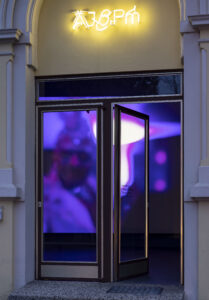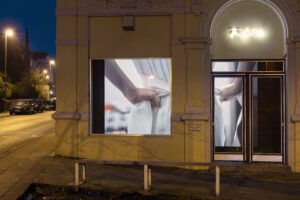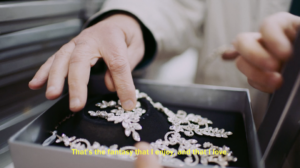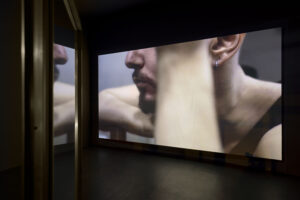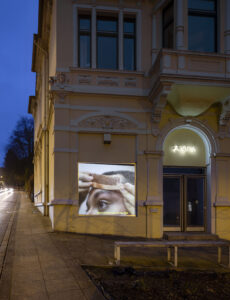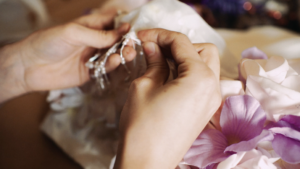18.24 Mohamad Abdouni ANYA KNEEZ: A Queen in Beirut
More
The result is an intimate, tender video portrait that captures and contrasts both day-to-day scenes and the preparations that go into transforming into a drag queen. The camera follows Anya as she sketches outfits, shops for jewelry and fabrics, applies makeup, tries on outfits, poses and performs. Amazingly, the extravagant drag queen costumes and accessories are created entirely within the confines of a tiny bedroom that doubles as both sleeping and sewing space; it is there that the trained fashion designer meticulously draws, designs, and stitches each piece with an abundance of love and attention to detail.
The main character casually shares her life story in a monologue, but not in a chronological or straightforward way; it feels more like one side of a conversation between friends. One quickly senses that the bond between Anya and the filmmaker is an intimate one, a friendship that allows these kinds of candid observations and expressions of trust to flow easily. Anya talks about her love of fashion, her studies in fashion design in New York, and her discovery of the performance art of drag. She associates the latter not only with self-liberation and the playful exploration of identities through fashion, but also with a powerful, exceptional emotional state: “I can’t really explain the emotion and the feeling that I get and the adrenaline rush, and the love for myself, and the insane amount of confidence when I put on a dress, or a jumpsuit, and paint my face and put on some boots, and walk out like I fucking own the world.” These shimmering emotions, this defiant self-confidence, come through in clip-like shots of Anya Kneez posing and dancing seductively in the light of a flickering strobe.
Anya’s fascination with drag goes hand in hand with her passion for all things sartorial, which she describes as follows: “I love clothes. That’s part of the reason why I went and got into this business and this industry. It’s because something about the idea of fashion, the idea that you can transform yourself and escape, even if just for a minute, the world that we live in through a piece of clothing.” The cultural practice of playfully navigating diverse genders and identities with fashion also finds parallels in contemporary self-staging on social media (filtered/unfiltered selfies), even extending to the art historical tradition of self-portraiture. The self-portrait becomes a space for projecting fantasies, making it particularly adept at articulating artistic self-perception and linking it back to the artist. With each act of self-staging, the portrayed self also becomes a cipher for collective longings, expectations, desires, or fears, as Cindy Sherman’s staged photographs convincingly show.
All these forms of self-presentation involve a playful exploration of gender identities on the one hand, and a negotiation of the (physical) desires of others on the other. The body is turned into a realm of potentiality, a narrative, a stage for expression through gestures, facial expressions, makeup, clothing, and accessories. It is the ambiguity, the fluidity that allows for imaginative exploration. It involves a preoccupation with an in-between bodily existence that is always present and yet constantly in need of redefinition as an experiential space and field of action. After all, within queer culture in particular, the body is simultaneously representation and a form of political activism—lived resistance to the normativization of bodies and subjectivity.
The positive memories, emotions, and freedoms Anya experienced during her formative years in the United States stand in stark contrast to her parents’ homophobic attitudes and the normative values of (Arab) society regarding masculinity. The result is an ongoing internal conflict that forces her to hide and deny aspects of her identity—to lead a double life. The video is presented from a deeply subjective point of view, focusing primarily on the biographical context, although her parents might also stand in for Lebanese society as a whole. Some of Anya’s words refer to both social and socio-political realities and the situation of the queer community in Lebanon. As such, this is a document in the sense of an oral history, one that allows contemporary witnesses to speak freely and openly. Anya recounts events, feelings, and aspects that she considers significant in her own voice, without interpretation or commentary by Mohamad Abdouni.
The documentary powerfully conveys a fundamental human desire: the need for every person to find a place in society, to feel accepted, to develop authentically so that their inner and outer selves are one—also beyond the confines of heteronormativity. In this light, the character of Anya Kneez emerges as a utopia in herself: a being from a gender-fluid future where individuals are free to express and be recognized for their true selves—a celebration of life’s full diversity.
Mohamad Abdouni (b. 1989, Lebanon) is an artist, photographer, filmmaker, and curator based between Beirut and Istanbul. He is also Editor in-Chief and Creative Director of COLD CUTS magazine, a photo journal exploring queer cultures in the SWANA (Southwest Asia/North Africa) region. His work has been exhibited in museums and galleries across the globe, including the Brooklyn Museum in New York (2017), FOAM Gallery in Amsterdam (2019), L’Institut du Monde Arabe and the Institut des Cultures d’Islam in Paris (2019), at Patel Brown in Toronto (2021), and the Lyon Biennale (2022). He is also the recipient of this year’s Lafayette Anticipations, awarded during his solo presentation at Paris+ par Art Basel with the gallery Marfa’ Projects. Mohamad Abdouni’s films have been screened at festivals including Eyes Wide Open Cinema (UK), the Leeds Queer Film Festival (UK), the International Queer & Migrant Film Festival in Amsterdam (NL), the Woodbury LGBTQ Film Festival in New Jersey (USA), and the Pink Apple Schwullesbisches Lesbian & Gay Film Festival in Zurich/Frauenfeld (CH). Commercially, he has shot for and directed films and music videos for well-known labels, brands and magazines including Gucci, Vogue US, Vogue Italy, Burberry, Puma, The New York Times, Slate, Fendi, Farfetch, GQ, King Kong, Dazed, AnOther, Nowness, Vice UK and L’officiel. His comprehensive research projects tend to focus on the untold stories of Beirut and uncovering the rich yet eradicated queer histories of the Arab-speaking region, specifically through documentaries and photo stories that have been featured in publications including A24, Telerama, Foam Magazine, Tetu, New Queer Photography, Kaleidoscope, i-D, Photoworks, and The Guardian. He has recently devoted himself to working on what is arguably the first archive of trans* histories in an Arab country, a project entitled Treat Me Like Your Mother: Trans* Histories From Beirut’s Forgotten Past. The collection is currently housed at the Arab Image Foundation in Beirut.
The result is an intimate, tender video portrait that captures and contrasts both day-to-day scenes and the preparations that go into transforming into a drag queen. The camera follows Anya as she sketches outfits, shops for jewelry and fabrics, applies makeup, tries on outfits, poses and performs. Amazingly, the extravagant drag queen costumes and accessories are created entirely within the confines of a tiny bedroom that doubles as both sleeping and sewing space; it is there that the trained fashion designer meticulously draws, designs, and stitches each piece with an abundance of love and attention to detail.
The main character casually shares her life story in a monologue, but not in a chronological or straightforward way; it feels more like one side of a conversation between friends. One quickly senses that the bond between Anya and the filmmaker is an intimate one, a friendship that allows these kinds of candid observations and expressions of trust to flow easily. Anya talks about her love of fashion, her studies in fashion design in New York, and her discovery of the performance art of drag. She associates the latter not only with self-liberation and the playful exploration of identities through fashion, but also with a powerful, exceptional emotional state: “I can’t really explain the emotion and the feeling that I get and the adrenaline rush, and the love for myself, and the insane amount of confidence when I put on a dress, or a jumpsuit, and paint my face and put on some boots, and walk out like I fucking own the world.” These shimmering emotions, this defiant self-confidence, come through in clip-like shots of Anya Kneez posing and dancing seductively in the light of a flickering strobe.
Anya’s fascination with drag goes hand in hand with her passion for all things sartorial, which she describes as follows: “I love clothes. That’s part of the reason why I went and got into this business and this industry. It’s because something about the idea of fashion, the idea that you can transform yourself and escape, even if just for a minute, the world that we live in through a piece of clothing.” The cultural practice of playfully navigating diverse genders and identities with fashion also finds parallels in contemporary self-staging on social media (filtered/unfiltered selfies), even extending to the art historical tradition of self-portraiture. The self-portrait becomes a space for projecting fantasies, making it particularly adept at articulating artistic self-perception and linking it back to the artist. With each act of self-staging, the portrayed self also becomes a cipher for collective longings, expectations, desires, or fears, as Cindy Sherman’s staged photographs convincingly show.
All these forms of self-presentation involve a playful exploration of gender identities on the one hand, and a negotiation of the (physical) desires of others on the other. The body is turned into a realm of potentiality, a narrative, a stage for expression through gestures, facial expressions, makeup, clothing, and accessories. It is the ambiguity, the fluidity that allows for imaginative exploration. It involves a preoccupation with an in-between bodily existence that is always present and yet constantly in need of redefinition as an experiential space and field of action. After all, within queer culture in particular, the body is simultaneously representation and a form of political activism—lived resistance to the normativization of bodies and subjectivity.
The positive memories, emotions, and freedoms Anya experienced during her formative years in the United States stand in stark contrast to her parents’ homophobic attitudes and the normative values of (Arab) society regarding masculinity. The result is an ongoing internal conflict that forces her to hide and deny aspects of her identity—to lead a double life. The video is presented from a deeply subjective point of view, focusing primarily on the biographical context, although her parents might also stand in for Lebanese society as a whole. Some of Anya’s words refer to both social and socio-political realities and the situation of the queer community in Lebanon. As such, this is a document in the sense of an oral history, one that allows contemporary witnesses to speak freely and openly. Anya recounts events, feelings, and aspects that she considers significant in her own voice, without interpretation or commentary by Mohamad Abdouni.
The documentary powerfully conveys a fundamental human desire: the need for every person to find a place in society, to feel accepted, to develop authentically so that their inner and outer selves are one—also beyond the confines of heteronormativity. In this light, the character of Anya Kneez emerges as a utopia in herself: a being from a gender-fluid future where individuals are free to express and be recognized for their true selves—a celebration of life’s full diversity.
Mohamad Abdouni (b. 1989, Lebanon) is an artist, photographer, filmmaker, and curator based between Beirut and Istanbul. He is also Editor in-Chief and Creative Director of COLD CUTS magazine, a photo journal exploring queer cultures in the SWANA (Southwest Asia/North Africa) region. His work has been exhibited in museums and galleries across the globe, including the Brooklyn Museum in New York (2017), FOAM Gallery in Amsterdam (2019), L’Institut du Monde Arabe and the Institut des Cultures d’Islam in Paris (2019), at Patel Brown in Toronto (2021), and the Lyon Biennale (2022). He is also the recipient of this year’s Lafayette Anticipations, awarded during his solo presentation at Paris+ par Art Basel with the gallery Marfa’ Projects. Mohamad Abdouni’s films have been screened at festivals including Eyes Wide Open Cinema (UK), the Leeds Queer Film Festival (UK), the International Queer & Migrant Film Festival in Amsterdam (NL), the Woodbury LGBTQ Film Festival in New Jersey (USA), and the Pink Apple Schwullesbisches Lesbian & Gay Film Festival in Zurich/Frauenfeld (CH). Commercially, he has shot for and directed films and music videos for well-known labels, brands and magazines including Gucci, Vogue US, Vogue Italy, Burberry, Puma, The New York Times, Slate, Fendi, Farfetch, GQ, King Kong, Dazed, AnOther, Nowness, Vice UK and L’officiel. His comprehensive research projects tend to focus on the untold stories of Beirut and uncovering the rich yet eradicated queer histories of the Arab-speaking region, specifically through documentaries and photo stories that have been featured in publications including A24, Telerama, Foam Magazine, Tetu, New Queer Photography, Kaleidoscope, i-D, Photoworks, and The Guardian. He has recently devoted himself to working on what is arguably the first archive of trans* histories in an Arab country, a project entitled Treat Me Like Your Mother: Trans* Histories From Beirut’s Forgotten Past. The collection is currently housed at the Arab Image Foundation in Beirut.
www.mohamadabdouni.com
Text Cynthia Krell
Translation Amy Patton
ANYA KNEEZ: A Queen in Beirut, 2017
Video, color, sound
10:53 min.
Courtesy of the artist and Marfa’, Beirut.
Photos Philipp Ottendörfer
Close
Text Cynthia Krell
Translation Amy Patton
ANYA KNEEZ: A Queen in Beirut, 2017
Video, color, sound
10:53 min.
Courtesy of the artist and Marfa’, Beirut.
Photos Philipp Ottendörfer

